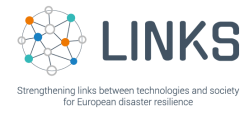
Nathan Clark (Scientific Coordinator of LINKS)
Kees Boersma (Principle Investigator of LINKS), VRIJE UNIVERSITEIT AMSTERDAM
At a period in time when the numbers and damaging effects of disasters are rising, and crises such as the COVID 19 pandemic are felt globally, communities are finding new and innovative ways to strengthen societal resilience. Among these approaches has been the growing utilization of social media and crowdsourcing (SMCS) technologies and services for the gathering and sharing of information among different community stakeholders in all phases of the disaster cycle. Decision makers, emergency and disaster management authorities, researchers, citizens and other actors are engaging with SMCS to communicate risk, and to plan for, mitigate, and respond to natural and human made hazards. The flow of information is becoming multi-directional, and relies on greater participation from all parts of society. At best, these processes have the ability to capture and share potentially live saving information which might otherwise be missed. At worst, the processes can overwhelm, mislead and misdirect different stakeholders and critical aid, thereby weakening societal resilience. At the heart of this dilemma is the need for a better understanding of the diverse ways and contexts in which SMCS is being used in disasters and crises. Moreover, it calls for the collection of ongoing knowledge and best practices on the topic, accessible to different levels of stakeholders.
The LINKS project kicked-off in the summer of 2020 with this exact ambition in mind. As a Research and Innovation project funding under the European Horizon 2020 Secure Societies framework 2019 (DRS01), LINKS has set out to govern the diversity around SMCS in disasters and crises, by creating a learning platform and LINKS Framework comprised of knowledge and best practices on the uses of SMCS for disaster risk management in Europe. LINKS is positioned among a number of related projects and networks under the DRS01 framework focused on different aspects of disaster resilience and vulnerability in Europe (e.g. Resiloc, Builders, Engage, CMINE), and contributes as the first project to provide a comprehensive European study on the impacts of SMCS in this domain. The project is supported by 15 partner institutions from 6 European countries, representing public authorities and emergency management agencies, research institutions, and civil society organizations. LINKS also pulls from the expert knowledge of associated partners in South Eastern Europe (the Disaster Preparedness and Prevention Initiative – DPPI-SEE) and Japan (Kobe University).
In December 2020, LINKS held a Year in Review meeting to look back at our achievements in 2020 and to create the roadmap for 2021. Now in our 8th month, LINKS is up and running at full speed due to the commitment of all partners. Nevertheless, the starting phase of the project has not been without challenges. The COVID-19 pandemic caused need for a virtual kickoff meeting for the project in June 2020, and continues to create challenges owing to the restrictions to institutions and movement across borders. For good reason, the consortium has not yet had the opportunity to meet in person. But as a complex project involving many partners, this has meant finding virtual ways to coordinate and collaborate efforts among the consortium, including the establishment of core project meeting days during the week, and more efficient formats for meetings, to give space for working and to avoid virtual burnout. It has also meant coming up with innovate ways to work together on project deliverables and to hold internal workshops, as well as coming up with mitigation strategies for the research activities scheduled to take place in person in the coming months and years, such as external workshops, focus groups, and interviews.
Despite setbacks, LINKS has also achieved much in the first phase of the project. The project has already held 9 internal seminars and workshops, 7 of which have been oriented specifically towards gathering the insights, expectations, and needs from the practitioner partners in the project. Key to the success of LINKS is the capitalization of knowledge within the consortium, particularly through the involvement of the practitioner partners actively engaging with SMCS for disaster and crisis management. These include institutions working with the LINKS hazard scenarios of flooding (Frederiksberg Kommune and HovedstadensBeredskab), droughts (Safety Innovation Center E.V.), earthquakes (Provincia Di Terni and Save the Children Italy), industrial hazards (Sitech Services and Veiligheidsregio Zuid-Limburg), and terror related events (Deutsche Hochschule Der Polizei), as well as European practitioner networks (Federation Of European Union Fire Officer Associations). These partners are involved in the design and execution of research, as well as in the validation and use of the project outputs. One reoccurring theme which has emerged from the workshops held thus far with practitioners has been around ways to better understand the correlation between risk communication and the subsequent actions taken by citizens to mitigate risk – an area which LINKS will continue to explore.
To date, LINKS has also submitted 12 project deliverables, including in-depth strategies for dissemination and communication activities, as well as for practical and ethical approaches for engaging with different stakeholders within the research of the project. In terms of research deliverables, the project has established three core knowledge bases, which form the foundations for the LINKS Framework. This includes and ongoing collection of state-of-the-art knowledge on disaster risk perception and vulnerability (DRPV), disaster management processes (DMP), and disaster community technologies (DCT) in Europe. The findings feed into the next stages of the project, which include the development of methodologies for the research taking place across different cases scenarios in Denmark (flooding), Italy (earthquakes), Germany (drought and terror related events), and the Netherlands (industrial hazards). The outputs from these studies will also feed into the design of the LINKS Framework, which should include best practices on the different uses, impacts and governance of SMCS in disasters. The consortium is now engaged in discussions on how to make the Framework accessible, usable and sustainable for different types of stakeholders.
Externally, LINKS continues to engage with DRS01 sister projects and make plans for collaboration across research and dissemination activities. One notable ongoing effort has been the collective work to combine glossaries across the projects in order to better align terminologies within the disaster risk management field. The combined glossaries will be shared publicly in due time. LINKS has also taken part in 5 external events including presentations at the TIEMS Annual Conference 2020 and the event organised by EURAXESS Japan on the collaboration between EU and Japan on specific research projects. The remarks and feedback from participants at these events showed a clear need for better understandings of the role SMCS in disasters considering the many diverse cultural, geographical, and situational conditions, which must be accounted for. Lastly, LINKS is working together with the EU Research Executive Agency (REA) to identify and define early policy drivers in the project in order to raise awareness and inform the policy development work of the relevant Directorate-Generals (DG) of the Commission (e.g. DG HOME, ECHO, CNECT). The first LINKS policy fiche has been shared with the REA and targets policy areas in disaster risk management and data governance, with reference to relevant EU policy areas (e.g. DRR, Civil Protection, Security, Science and Policy, Telecommunication, Data Protection, etc.).
Moving forward, LINKS is busy refining the research design for the case assessments as well as working on the design and workplans for the LINKS Framework and an online learning platform around the LINKS topics. With key deliverables for these components due in February and May of 2021, we will continue to find resourceful ways to harness the knowledge and participation of the full consortium including a number of brainstorming workshops set for the spring. We will also bring in external stakeholder knowledge through the research and via seminars with experts, and work to disseminate the project results through cooperation with the DRS01 network and others. Two upcoming events planned include an internal mini-conference among the DRS01 projects in early February, and panel hosted LINKS at the European Geosciences Union (EGU) General Assembly in April, titled The role of Social Media and Crowdsourcing in Disaster Risk Management and Resilience.
June 2021 will also bring about the one-year anniversary for LINKS and the first project review with the Commission. Beyond that, we have high hopes and ambitions for 2021 and look forward to having the opportunity for the consortium to begin to travel and have in-person meetings and workshops. We have put in place contingency plans for an extended period of virtual operations, but with the hope that they will not be necessary for much longer. We will see what the future brings, and be ready for it!

